The Ultimate Bible of Ecommerce Statistics for 2023

The ecommerce industry is rapidly growing and evolving, and staying informed is key to success. To help keep you in the know for what’s pertintent this year and beyond, we’ve created the most in-depth and comprehensive Bible of important ecommerce statistics you need to know for 2023 and beyond. From general ecommerce trends to mobile shopping and social media, we’ll cover everything you need to stay ahead of the curve. So let’s dive in!
General Ecommerce Statistics
Ecommerce has been growing at an astounding rate, with online sales continually breaking records each year. With the increasing importance of ecommerce in the global market, it’s vital for businesses to stay informed on the latest trends, statistics, and strategies.

- According to Statista, global ecommerce sales are projected to reach $3.53 trillion in 2019. This growth can be attributed to various factors, including the rise of mobile commerce, social media integration, and advancements in technology that make online shopping more accessible and convenient for consumers.
- A study by Accenture revealed that 77% of consumers participate in at least one retail loyalty program.
- Invesp reported that it costs five times more to acquire a new customer than to retain an existing one.
- According to a study by KPMG, 81% of consumers are more likely to continue doing business with brands that offer loyalty programs.
- A Marketing Dive report found that 57% of consumers are more likely to spend more on brands to which they are loyal.
- Statista predicts that by 2023, mobile ecommerce will account for 72.9% of total ecommerce sales.
- A report by Google found that 73% of consumers would switch to a better-designed mobile site if they encountered a poorly designed one.
- OuterBox reported that 40% of all online purchases made during the holiday season are done on smartphones.
- According to Adobe, 61% of email users prefer to read emails on their mobile devices.
- BigCommerce reported that online stores with a social media presence have an average of 32% more sales than those without one.
- A study by Kinsta found that 74% of consumers rely on their social networks to make purchasing decisions.
- According to Shopify, 85% of orders from social media sites come from Facebook.
- Neil Patel reported that social media posts with photos receive 53% more likes, 104% more comments, and 84% higher click-through rates.
- OptinMonster found that email marketing yields a 4400% ROI, with 1 spent.
- Campaign Monitor reported that segmented email campaigns drive a 760% increase in revenue.
- According to Experian, transactional emails generate 8x more opens and clicks than other types of email campaigns, making 6x the revenue.
- A study by OptinMonster revealed that 60% of consumers have made a purchase as a result of an email marketing message they received.
- Baymard Institute found that the average cart abandonment rate across all industries is 69.89%.
- Disruptive Advertising estimated that ecommerce sites could be losing a total of $3 billion a year due to cart abandonment.
- According to the Baymard Institute, ecommerce sites can gain a 35% increase in conversion rates with an optimized checkout design.
- OptinMonster reported that mobile devices have the highest cart abandonment rate at 78%, followed by tablets (70%) and desktops/laptops (67%).
- Mar Tech reported that 44% of consumers say they will likely become repeat buyers after a personalized shopping experience.
- According to Salesforce, 57% of online shoppers are willing to share personal data in exchange for personalized offers or discounts.
- A study by Accenture found that 91% of consumers are more likely to shop with brands that provide relevant offers and recommendations.
- McKinSey reported that 74% of customers feel frustrated when website content is not personalized.
- Statista predicts that the number of digital buyers worldwide will reach 2.14 billion by 2023.
- According to eMarketer, China is the largest ecommerce market in the world, accounting for over 50% of global ecommerce sales.
- Statista estimates that ecommerce will account for 21.8% of total retail sales worldwide by 2023, up from 14.1% in 2019.
- Shopify reported that global retail ecommerce sales are expected to reach $7.6 trillion by 2025.
- A Seller App stury found that 73% of consumers use multiple channels during their shopping journey.
- According to Forbes, synthesized retail, which focuses on integrating all customer touchpoints into a single, unified experience, is the future of retail.
- A study by the CMO Council found that 85% of marketers believe that a cohesive customer experience across all channels is critical to their success.
- Soft Tec reported that businesses with omni-channel customer engagement strategies retain 89% of their customers, compared to 33% for companies with weak omni-channel engagement.
- Gartner predicts that by 2023, over 60% of companies will rely on AI-driven personalization to deliver tailored customer experiences.
- Business Insider estimates that by 2023, there will be over 64 billion IoT devices worldwide, presenting new opportunities for ecommerce businesses to leverage connected devices for sales and marketing.
- Forbes predicts that voice commerce will become a major player in the ecommerce landscape, with voice-activated purchases expected to reach $40 billion by 2023.
- Walker Sands reported that 79% of consumers expect to see drone deliveries in the next five years, indicating a potential shift in ecommerce logistics and fulfillment.
- Global ecommerce sales are expected to reach $6.3 trillion by 2024, growing at a compound annual growth rate (CAGR) of 8.1% from 2023.
- By 2023, the number of digital buyers worldwide is projected to reach 2.14 billion, accounting for over 25% of the global population.
- The Asia-Pacific region is expected to account for 60.5% of global ecommerce sales by 2023, with China being the largest market.
Ecommerce Market Share and Competition
The ecommerce landscape is rapidly evolving, with new platforms, technologies, and consumer behaviors shaping the industry’s future. As we head into 2023, understanding the market share and competition dynamics is crucial for businesses looking to succeed in the digital space. Unsurprisingly, Amazon leads the pack, and for many solid reasons.

- Ecommerce market share is dominated by a few key players that have established themselves as industry leaders. In 2023, Amazon is expected to maintain its position as the largest ecommerce platform, with a 38.7% share of the US ecommerce market. Globally, Amazon’s market share is estimated at around 14%.
- China’s Alibaba Group, which includes platforms like Alibaba, Taobao, and Tmall, holds a significant share of the global ecommerce market. In 2023, Alibaba is expected to account for 56% of China’s ecommerce market, solidifying its position as a dominant player in the industry as it competes with Amazon for marketplace dominance.
- Other notable ecommerce platforms include eBay, Rakuten, and Walmart, each commanding a smaller yet significant share of the market. As competition intensifies, these platforms are continually innovating to attract and retain customers.
- As consumers demand more personalized experiences, ecommerce platforms are leveraging technologies like AI and machine learning to create customized product recommendations, tailored marketing messages, and dynamic pricing strategies.
- Social media platforms are increasingly becoming integral to the ecommerce ecosystem, with features like shoppable posts, buy buttons, and integrated payment solutions. In 2023, global social commerce sales are expected to reach $1.2 trillion, making it a critical channel for ecommerce businesses to leverage.
- As voice-assistant technology improves, more consumers are using voice commands to search for products, make purchases, and track orders. By 2023, voice commerce is predicted to account for over $80 billion in sales.
- Eco-conscious consumers are increasingly seeking out sustainable products and environmentally friendly packaging. Ecommerce businesses that prioritize sustainability are likely to gain a competitive edge in the market.
- In 2023, the Asia-Pacific region is projected to account for 62.6% of global ecommerce sales, fueled by the rapid growth of China, India, and Southeast Asia. North America and Europe will follow, with 19% and 12.7% of global sales, respectively.
- Latin America, the Middle East, and Africa are expected to experience significant growth, albeit from a smaller base. As internet penetration and smartphone adoption increase in these regions, ecommerce businesses have significant opportunities to tap into these emerging markets.
- Mobile commerce (mcommerce) is a rapidly growing segment within the ecommerce industry. By 2023, mcommerce is expected to account for 72.9% of global ecommerce sales, amounting to over $3.5 trillion. Factors such as increasing smartphone penetration, improved mobile internet connectivity, and the development of mobile-optimized websites and apps are driving this growth.
- Cross-border ecommerce is gaining popularity as consumers seek out unique products and competitive prices from international sellers. By 2023, cross-border ecommerce sales are expected to reach $1 trillion, accounting for 22% of global ecommerce sales. Businesses looking to expand their global reach should consider investing in cross-border ecommerce strategies, including localized websites, multi-currency payment options, and efficient logistics and shipping solutions.
- Emerging markets represent significant growth opportunities for ecommerce businesses, as increasing internet penetration, rising middle-class populations, and improving digital infrastructure drive online shopping adoption. By 2023, ecommerce sales in emerging markets are expected to grow at a CAGR of 25%, with India, Indonesia, and Mexico among the fastest-growing markets.
- Ecommerce has disrupted various industries, with some sectors experiencing more significant shifts towards online sales than others. In 2023, the following industries are expected to have the highest ecommerce market share:
- Fashion and Apparel: 36% of global sales
- Consumer Electronics: 22% of global sales
- Health and Beauty: 11% of global sales
- The top 10 ecommerce retailers account for 63.2% of total US ecommerce sales.
- There are an estimated 12 million to 24 million ecommerce sites worldwide, but less than 1 million of these sell more than $1,000 per year.
Consumer Behavior and Ecommerce
Understanding consumer behavior in the context of ecommerce is essential for businesses looking to excel in the online retail landscape. As we move into 2023 and beyond, it’s crucial to stay informed in order to make data-driven decisions and optimize your ecommerce marketing strategy.
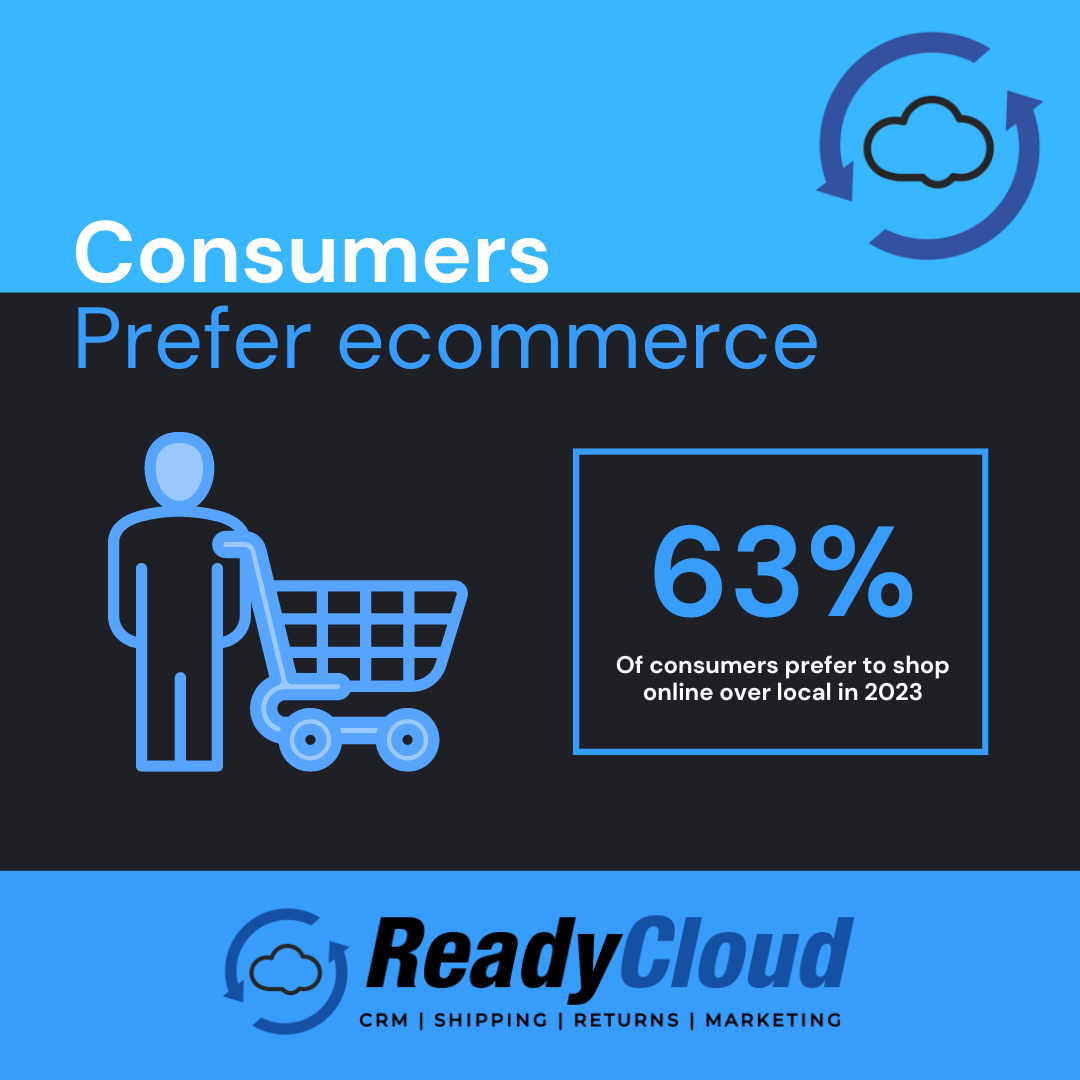
- As more and more consumers embrace online shopping, there has been a significant shift in their preferences and behavior. A 2023 Forrester report suggests that 63% of consumers now prefer to shop online rather than in physical stores. This preference is driven by factors such as convenience, variety, and the ability to compare prices and read reviews before making a purchase.
- The rise of smartphones and mobile devices has had a significant impact on consumer behavior and ecommerce. Statista reports that 82% of internet users in the United States have used a mobile device to shop online, and this number is expected to grow. As a result, optimizing ecommerce websites for mobile devices has become a priority for online retailers.
- Despite the growing popularity of mobile shopping, conversion rates on mobile devices tend to be lower than those on desktops and laptops. According to Marketing Land, mobile apps have a 3x higher conversion rate than mobile websites. This highlights the importance of investing in mobile app development and optimization for ecommerce businesses.
- Personalization plays a crucial role in shaping consumer behavior and driving ecommerce success. An Accenture study found that 91% of consumers are more likely to shop with brands that provide relevant offers and recommendations. This demonstrates the value of using personalized marketing strategies to engage and retain customers.
- 54% of consumers say they prefer shopping online over in-store, citing convenience, better prices, and a wider selection
- Approximately 49% of consumers shop online at least once a week, while 30% shop online multiple times per week.
Ecommerce User Experience
Ecommerce user experience (UX) has become a critical factor in determining the success of online businesses. As the ecommerce landscape continues to evolve, staying up-to-date with the latest UX trends and best practices is essential for driving sales and customer satisfaction that can help you notch more wins while avoiding common ecommerce mistakes that can detract from performance metrics.
- A well-designed ecommerce UX can have a significant impact on conversion rates. In fact, Forbes estimates that a well-executed UX design could increase conversion rates by 200-400%. This underscores the importance of investing in UX improvements to drive sales and revenue growth.
- Effective ecommerce UX also plays a crucial role in fostering customer loyalty and retention. A Forbes report found that 73% of customers cite a positive experience as the main driver of their brand loyalty. By providing a seamless and enjoyable online shopping experience, businesses can build long-lasting relationships with their customers and encourage repeat purchases.
- Site navigation and search functionality are critical for helping customers find the products they need quickly and easily. Poor navigation can lead to frustration and may ultimately result in customers abandoning their shopping carts. In fact, Baymard Institute reports that 50% of ecommerce websites have issues with their main navigation, which can hinder the user experience.
- With Statista reporting that over 50% of global web traffic comes from mobile devices, ensuring that your ecommerce site is mobile-responsive is more critical than ever. A mobile-optimized site should load quickly, have easy-to-use navigation, and display content in a visually appealing and easy-to-read manner on smaller screens.
- High-quality product pages and descriptions are essential for helping customers make informed purchasing decisions. A study by Retail Dive found that 40% of consumers have returned an item they purchased online due to inaccurate product descriptions. To avoid this, ensure that product pages include detailed descriptions, high-resolution images, and user-generated content such as reviews and ratings.
- A seamless and efficient checkout process is crucial for reducing cart abandonment and driving conversions. According to Baymard Institute, the average cart abandonment rate is 69.8%, with 21% of users citing a long or complicated checkout process as the primary reason for abandoning their carts. Streamlining the checkout process by reducing the number of steps, offering guest checkout options, and providing multiple payment options can significantly improve the user experience and lead to higher conversion rates.
- Voice-activated shopping is on the rise, with Venture Beat predicting that voice shopping will reach $40 billion in the US alone by 2022. Integrating voice search and voice-activated purchasing capabilities into your ecommerce site can provide a more seamless and convenient shopping experience for customers.
- Augmented reality (AR) and virtual reality (VR) technologies are becoming increasingly popular in the ecommerce space, offering customers immersive and interactive shopping experiences. Entreprenuer predicts that by 2023, 25% of digital workers will use a virtual employee assistant daily, up from less than 2% in 2019. Integrating AR and VR features into your ecommerce site, such as virtual try-ons or 3D product visualizations, can help enhance user experience and drive sales.
- 88% of online shoppers say they wouldn’t return to a website with a poor user experience, emphasizing the importance of a well-designed ecommerce site.
- Offering free shipping can increase ecommerce conversion rates by up to 50%.
Mobile Ecommerce (Mcommerce) Statistics
As we rapidly approach 2023, the world of ecommerce continues to evolve, with mobile ecommerce (mcommerce) taking center stage. With the increasing number of smartphone users and advancements in technology, mcommerce has become an essential aspect of online shopping for both consumers and businesses. These facts about mobile commerce can help you better position your brand to notch new wins in 2023 and beyond.
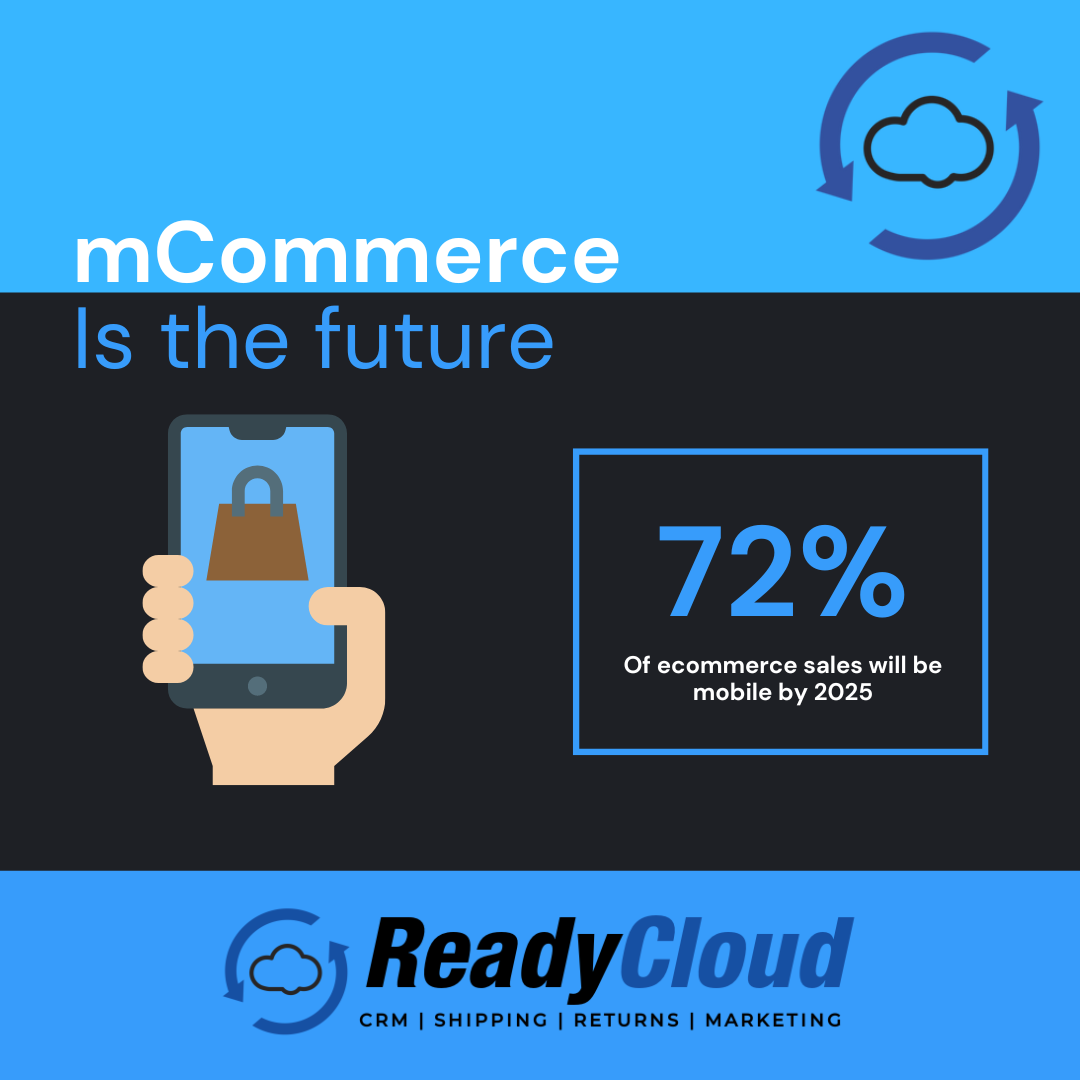
- According to Statista, the global mcommerce market is expected to reach $3.56 trillion in 2021, accounting for 72.9% of total ecommerce sales. With this rapid growth, it’s crucial for businesses to understand the latest trends and statistics in order to remain competitive in the market.
- The global mcommerce market is projected to grow at a CAGR of 25.5% between 2021 and 2028, reaching a value of $58 trillion by 2028.
- Asia-Pacific leads the global mcommerce market, with a 64% share in 2021, followed by North America and Europe.
- In 2022, an estimated 2.14 billion people worldwide will have made at least one purchase via mobile device, representing 27.3% of the global population.
- By 2023, it is projected that 91% of internet users in the United States will have made a purchase using a mobile device.
- 79% of smartphone users have made a purchase online using their mobile device in the last six months, and mobile devices accounted for 65% of all ecommerce traffic in 2021, with 35% coming from desktops.
- In 2021, mobile devices accounted for 54% of total ecommerce sales, while desktops accounted for 46%.
- 85% of mobile users prefer native mobile apps to mobile websites when shopping online.
- Mobile apps have a 3x higher conversion rate compared to mobile websites.
- By 2023, there will be an estimated 1.31 billion mobile wallet users worldwide, up from 950 million in 2019.
- Social commerce, the integration of social media and ecommerce, is expected to account for 4.3% of total ecommerce sales in the United States by 2023, up from 1.8% in 2019.
- In 2021, 43% of global internet users aged 16-64 purchased a product they discovered on social media.
- Slow-loading mobile sites lead to a 106% increase in bounce rates, with 53% of mobile users abandoning a site if it takes longer than 3 seconds to load.
- 88% of consumers are less likely to return to a mobile site after a poor user experience.
- Augmented reality (AR) is expected to play a significant role in mcommerce, with 61% of consumers saying they prefer retailers that offer AR experiences.
- Voice commerce is projected to reach 8 billion in the United Kingdom by 2023.
- Mobile commerce is expected to account for 72.9% of total ecommerce sales by 2023.
- In 2022, mobile devices were responsible for 68% of total ecommerce traffic.
- The global mobile payment market is projected to reach $12.06 trillion by 2027, growing at a CAGR of 30.7% from 2023.
Returns
The ecommerce industry has been growing rapidly in recent years, with more and more businesses embracing online selling. As a result, ecommerce return policies and practices have become a crucial aspect of the customer experience. Here are some important statistics on ecommerce returns to know in 2023.
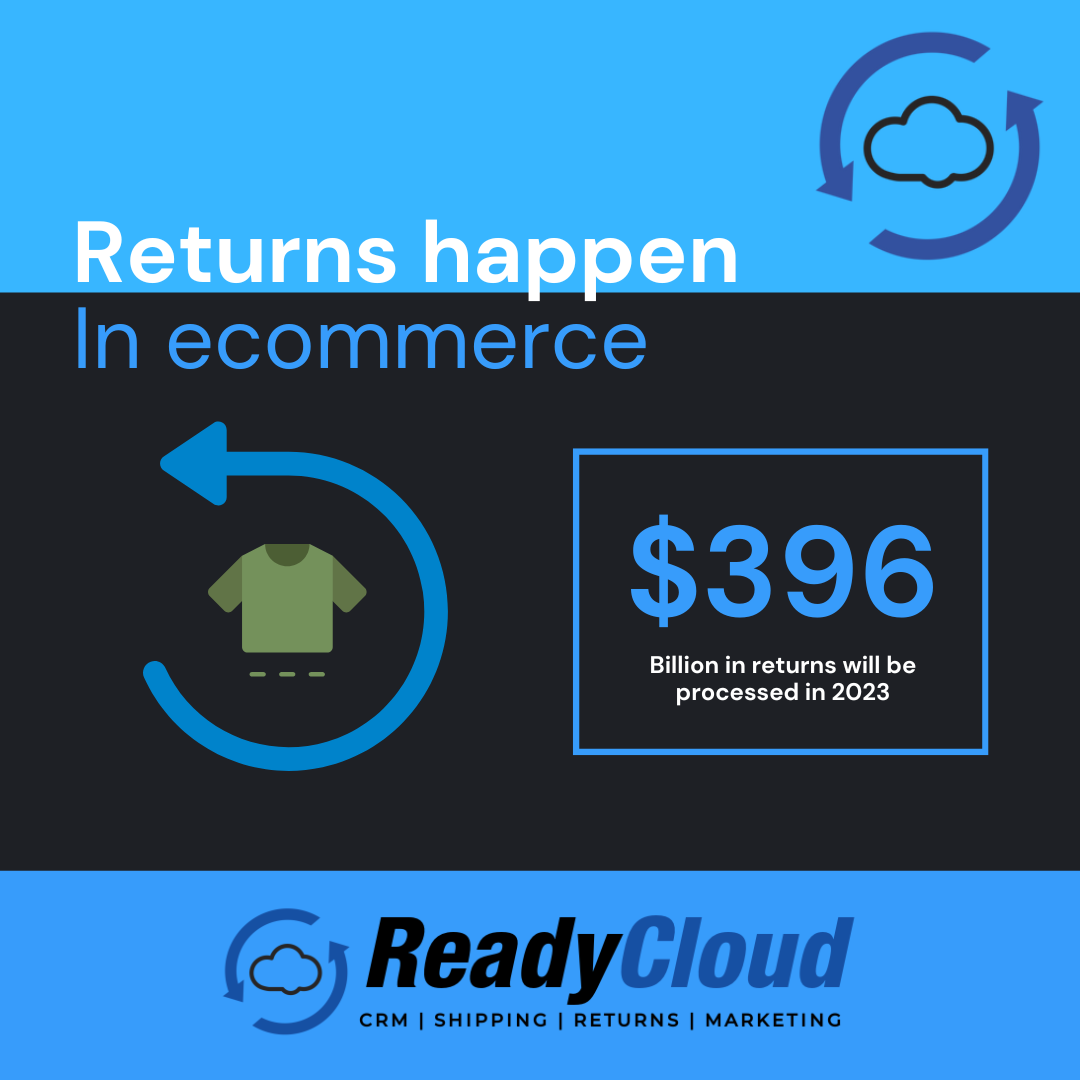
- Studies have found that return rates for ecommerce are increasing, with the average return rate for online purchases being around 16%. This is significantly higher than the average return rate for brick-and-mortar stores, which hovers around 8%.
- The cost of processing returns can be quite high for ecommerce businesses. In the United States alone, the total cost of processing returns was $369 billion in 2018. This figure is expected to increase as ecommerce continues to grow.
- According to a study by Retail Wire, the average cost of processing a return is 8 per item. These costs can quickly add up, particularly for businesses with high return rates.
- One of the most common reasons for returns in the ecommerce industry is incorrect sizing or fit. A study by ReadyReturns found that most returns (22%) are due to products not fitting as expected, making it essential for online retailers to provide accurate sizing information and guides.
- Another common reason for returns is dissatisfaction with the product itself. Whether it’s due to poor quality, not meeting expectations, or simply not liking the product, and 19% of returns can be attributed to product dissatisfaction.
- A study by ReadyReturns found that 49% of online shoppers check the return policy of an ecommerce store before making a purchase. Moreover, 72% of shoppers are more likely to shop with a retailer that offers a hassle-free returns process.
- 90% of customers cited free returns as a major factor in their overall satisfaction with an online retailer. Offering free returns can encourage customers to make a purchase, knowing they can return the item without incurring additional costs.
- To combat the issue of sizing and fit, some retailers are experimenting with virtual try-on technology and personalization. Companies like True Fit and Fits.me offer solutions that help customers find the right size and fit before making a purchase, reducing the likelihood of returns.
- As the ecommerce industry continues to expand, so does the volume of returns. According to Statista, global ecommerce sales are projected to reach 4.28 trillion in 2020. This growth is expected to result in a corresponding increase in the number of returns.
- The fashion industry is particularly affected by high return rates, with Statista reporting that clothing, shoes, and accessories account for 56% of all online returns in the US. This is due to factors such as sizing issues, color discrepancies, and the tactile nature of these products, which make it difficult for customers to assess them accurately online.
Mobile Shopping Behavior
Mobile shopping behavior has seen a significant shift in recent years, driven by the widespread adoption of smartphones and advancements in mobile technology. As consumers increasingly rely on their mobile devices to browse, research, and purchase products, businesses must adapt to meet the evolving needs and preferences of their target audience.

- Mobile ecommerce, or mcommerce, has been growing rapidly and is expected to continue its upward trajectory in the coming years. According to Statista, global mobile ecommerce sales are projected to reach $3.56 trillion in 2023, accounting for 72.9% of total ecommerce sales. This represents a significant increase from 58.9% in 2018, highlighting the growing importance of mobile shopping for businesses.
- As mobile ecommerce continues to grow, more consumers are using their smartphones to shop online. Research by eMarketer estimates that in 2023, 90.8% of internet users worldwide will have made at least one purchase via a mobile device. This indicates that businesses must prioritize optimizing their online stores for mobile devices to capture this large and growing audience.
- Mobile devices have also been surpassing desktops in terms of online shopping activity. A study by Adobe Digital Insights found that in 2018, mobile devices accounted for 58% of site visits and 39% of revenue for online retailers during the holiday season. This trend is expected to continue in 2023 and beyond, with mobile devices playing an increasingly dominant role in ecommerce.
- Consumers are increasingly turning to their mobile devices to research products before making a purchase. According to a recent study, 82% of smartphone users consult their phones while in a store, and 45% read reviews to make informed purchasing decisions. Businesses must ensure that their online presence is optimized for mobile devices to provide these potential customers with the information they seek.
- As mobile shopping increases in popularity, so too does the use of mobile wallets for making purchases. According to Juniper Research, the number of mobile wallet users worldwide is expected to reach 5 billion by the end of 2026. This represents a significant opportunity for businesses to adopt mobile wallet payment options to cater to this growing audience.
- In-app purchases are becoming an increasingly popular method of payment for mobile shoppers. Global consumer spending on in-app purchases will reach $156.5 billion, representing a compound annual growth rate (CAGR) of 16.6% from 2018 to 2023. This highlights the need for businesses to offer seamless in-app payment solutions to facilitate mobile shoppin
- Alternative payment options, such as cryptocurrency and biometric payments, are also gaining traction among mobile shoppers. A study by Worldpay found that by 2023, digital wallets will account for 40% of online payments, with alternative payment methods making up an additional 17%. Businesses should stay informed about these emerging payment options to cater to consumers’ evolving preferences.
- Despite the growing popularity of mobile shopping, cart abandonment rates remain a significant challenge for businesses. Research by Hot Jar indicates that the average cart abandonment rate on mobile devices is 85.65%, compared to 73.07% on desktops. This suggests that businesses must prioritize improving the mobile shopping experience to reduce cart abandonment and increase conversions.
- Slow-loading mobile websites can negatively impact the user experience and contribute to higher cart abandonment rates. A study by Google found that if a mobile page takes more than three seconds to load, the probability of a user abandoning the site increases by 32%. Businesses must optimize their mobile websites for speed to ensure a seamless shopping experience for their customers.
- Security concerns also factor into consumers’ mobile shopping behavior. More than 55% of consumers are concerned about the security of their personal information when shopping on mobile devices. Businesses must prioritize mobile security and communicate their commitment to protecting customer data to build trust and encourage mobile shopping.
- As mobile shopping continues to grow, businesses are investing more in mobile advertising to reach their target audience. According to eMarketer, mobile ad spending is expected to reach $247.36 billion in 2023, accounting for 67% of total digital ad spending. This highlights the importance of mobile advertising in driving ecommerce growth.
- Effective mobile marketing strategies are essential for businesses looking to capitalize on the growth of mobile shopping. A study by Smart Insights found that personalized mobile messaging, location-based marketing, and mobile-first content are among the most effective tactics for engaging mobile shoppers. Businesses should consider implementing these strategies to enhance their mobile marketing efforts.
- Social media plays a crucial role in influencing mobile shopping behavior. Shopify reports that 85% of orders from social media sites come from Facebook. Businesses should leverage social media to drive mobile shopping and boost sales.
- Augmented reality is emerging as a powerful tool for enhancing the mobile shopping experience. According to Gartner, 100 million consumers will use AR to shop by 2023. By incorporating AR into their mobile shopping platforms, businesses can provide a more immersive and engaging experience for their customers, potentially leading to increased sales.
- Voice shopping is another trend to watch in the coming years, as more consumers become comfortable using voice-activated assistants to make purchases. A report by Voicebot estimates that voice shopping will reach $40 billion in the United States by 2022. Businesses should consider integrating voice shopping capabilities into their mobile ecommerce platforms to cater to this growing audience.
- Artificial intelligence is expected to play an increasingly prominent role in mobile shopping, with AI-powered chatbots and personalized product recommendations becoming more prevalent. AI can potentially increase global ecommerce revenues by $439 billion by 2023. By leveraging AI technology, businesses can offer a more personalized and streamlined mobile shopping experience for their customers.
Email Marketing and Ecommerce
The ever-evolving landscape of ecommerce demands that businesses stay abreast of the latest trends to maintain a competitive edge. One such trend is the increasing reliance on email marketing as a powerful tool for driving customer engagement and generating sales. Use these statistics on email marketing to improve your strategy and enhance your brand’s reach.
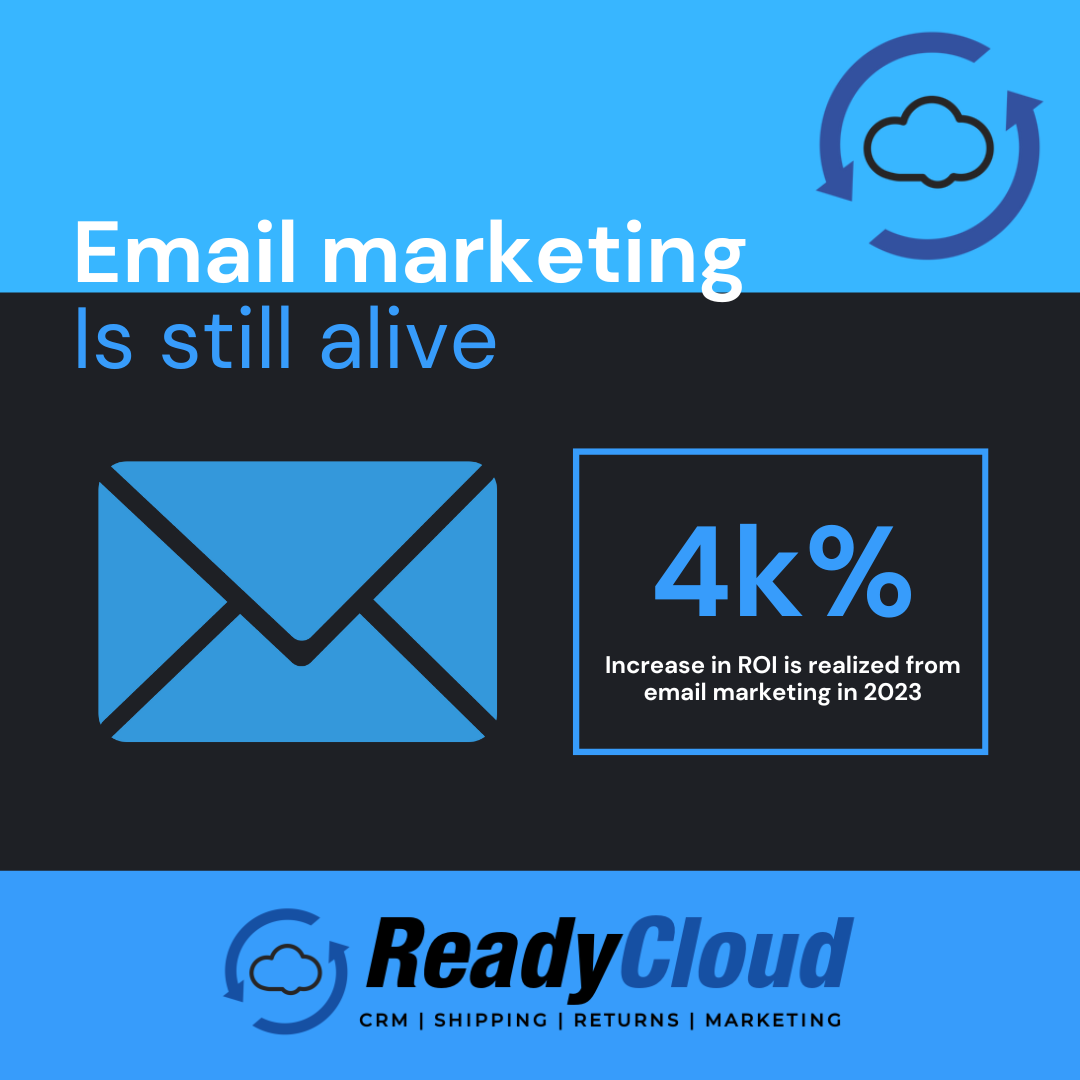
- According to Statista, the number of email users worldwide reached 4.258 billion in 2022, highlighting the massive potential audience for email marketing campaigns.
- As per Statista, global email marketing revenue is projected to reach $9.62 billion in 2022, further illustrating its importance to the ecommerce sector.
- A study by Mail Chimp reveals that 69% of businesses use email marketing as a digital marketing strategy, proving its widespread adoption and effectiveness.
- Email marketing campaigns account for 9% of the total traffic on ecommerce websites, according to Statista. This highlights the significant role email marketing plays in driving online sales.
- A Digital Commerce 360 survey of retailers found that 36% of them invest more than 11% of their digital marketing budget into email marketing, demonstrating its priority in their overall marketing strategy.
- Ecommerce emails boast one of the highest deliverability rates at 96%.
- MailChimp reports that the average open rate for ecommerce marketing emails is 15.68%, while the average click rate is 2.01%. These figures indicate that customers are highly engaged with well-crafted email campaigns.
- Another interesting statistic from MailChimp is that only 0.19% of ecommerce marketing emails get hard-bounced, suggesting that businesses have become more efficient at managing their email lists and avoiding undeliverable emails.
- According to Campaign Monitor, emails with personalized subject lines see a 26% increase in open rates, proving that personalization is crucial for capturing the attention of recipients.
- Hubspot reveals that mobile-friendly email is the second most popular strategy email marketers use to boost their performance, highlighting the importance of optimizing emails for different devices.
- Retail Dive found that 47% of consumers prefer email as their pre-purchase method of contact, and 75% of them like to receive emails on discounts and offers. This demonstrates the potential of email marketing in influencing consumer behavior.
- Research by Omnisend finds that welcome messages have the highest conversion rate of 51.94% among all automated emails in ecommerce.
- A recent study reveals that 58% of the top 1,000 US ecommerce businesses send welcome emails, further emphasizing their importance in nurturing customer relationships.
- More than half of customers say that emails affect their purchasing decisions.
- OptinMonster found that 60% of respondents claimed to have made a purchasing decision due to receiving a promotional email, highlighting the power of email marketing in driving sales.
- Campaign Monitor reports that marketers see a 760% increase in returns from email when moving to segmented campaigns, emphasizing the importance of targeting and personalization in email marketing.
- Segmented email campaigns drive a 760% increase in revenue.
- Personalized subject lines can increase email open rates by 26%.
- Email marketing has the highest ROI of all marketing campaigns.
- Personalized subject lines can increase email open rates by 26%.
Abandoned Cart Statistics
Cart abandonment is a prevalent issue in online retail, with a significant impact on businesses. Understanding the reasons behind cart abandonment and implementing strategies to address these issues can help businesses recover lost sales and improve their overall conversion rates.
By focusing on streamlining the checkout process, offering transparent shipping costs, building trust with security measures, optimizing the shopping experience for mobile devices, and utilizing retargeting and email marketing strategies, businesses can effectively reduce cart abandonment rates and enhance their overall online shopping experience. Use these recent shopping cart abandonment statistics to improve your checkout process and attract new sales.

- According to recent studies, the average cart abandonment rate stands at 69.82%. This means that more than half of all online shopping carts are abandoned at any given time. However, it’s important to note that this figure is an average, and the actual rate may vary significantly among different industries and businesses.
- A complicated checkout process is a major deterrent for online shoppers. In fact, 18% of potential customers would rather not purchase than go through a complex checkout process. Streamlining the checkout flow and reducing the number of steps can help mitigate this issue.
- Shipping costs have a significant impact on cart abandonment, with up to 70% of shoppers abandoning their carts when they see high shipping fees. Offering free shipping or providing transparent shipping costs upfront can help alleviate this issue.
- Technical issues such as website crashes or errors can lead to a 12% abandonment rate. Ensuring a smooth and error-free browsing experience is crucial in retaining potential customers.
- 17% of online shoppers abandon their carts due to concerns about the security of their payment information. Building trust by implementing secure payment gateways and displaying security badges can help mitigate this concern.
- Forcing shoppers to create an account before checking out is another significant reason for cart abandonment, with 24% of shoppers leaving their carts for this reason. Allowing guest checkouts can help reduce cart abandonment in this regard.
- Cart abandonment rates can vary significantly across different industries. For example, the automotive industry has the highest cart abandonment rate at 89.11%, followed by the airline and fashion industries at 88.87% and 88.57%, respectively. On the other hand, the grocery industry has the lowest rate at 61.13%, followed by consumer electronics at a rate of 70.65%.
- Cart abandonment rates also vary depending on the device used for shopping. In Q2 of 2021, the cart abandonment rate was 80.6% on mobile phones and 66.1% on desktops. This highlights the importance of optimizing the shopping experience for mobile devices to reduce cart abandonment.
- Retargeting ads can be an effective strategy to bring back non-converting shoppers to your website. These ads include display ads and Facebook ads, which allow advertisers to show specific ads to specific groups of people. Retargeted ads result in 30% of non-converting shoppers returning to the website where they abandoned their carts.
- Email marketing can be a highly effective tool for recovering abandoned carts. Sending a strategic series of reminder emails, followed by incentives such as coupons or free shipping codes, can help bring customers back to complete their purchase. The average open rate for abandoned cart emails is 44%, with a click-through rate of 21%. Furthermore, the average conversion rate for these emails is 10.7%, making it a valuable tool for recovering lost sales.
- Offering free shipping and returns can significantly influence purchase decisions, especially for customers under 25. Over 50% of this demographic cites same-day shipping as the number one factor driving them to make an online purchase. In addition, 54% say they are more likely to shop online when free returns or exchanges are guaranteed.
- Enhancing user experience can play a crucial role in reducing cart abandonment rates. For instance, 63% of online shoppers who use mobile apps prefer them because they are more convenient than mobile sites. Retail apps are perceived as faster, offer better benefits and rewards, and improve the user experience by storing settings. Focusing on improving the overall user experience can significantly impact cart abandonment rates.
- Abandoned cart emails have an average open rate of 45%.
- Sending three abandoned cart emails can result in 69% more orders compared to a single email.
Influencer Marketing and Ecommerce
In the ever-evolving landscape of digital marketing, influencer marketing has emerged as a powerful tool for brands to reach their target audience. As e-commerce continues its steady growth, understanding the impact of influencers on consumer behavior is essential for businesses looking to stay ahead of the curve.
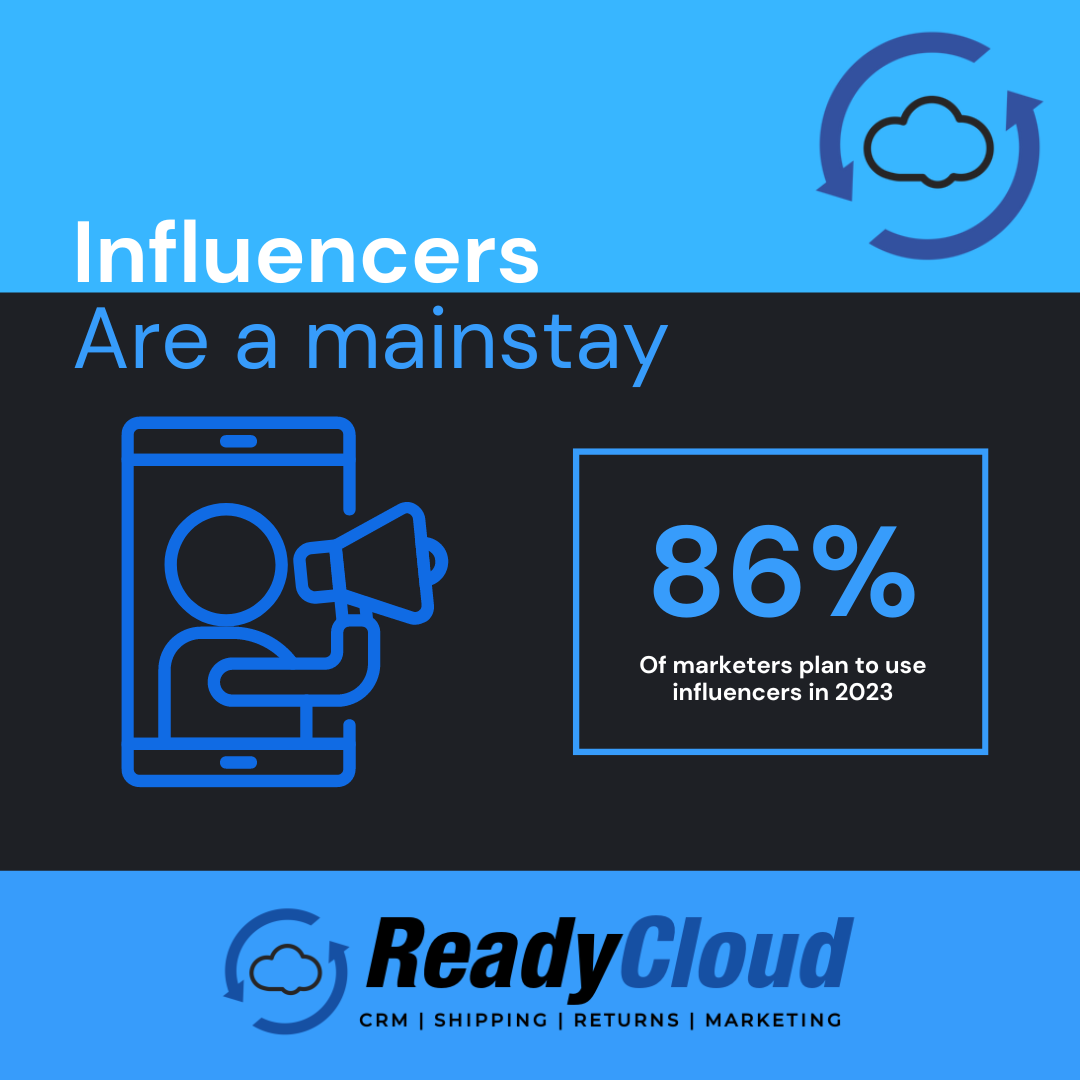
- According to a report by Business Insider, the influencer marketing industry is projected to reach 8 billion in 2020. This considerable growth demonstrates the increasing importance of influencer marketing in the overall advertising landscape.
- Research by HubSpot found that 86% of marketers plan to include influencer marketing in their marketing mix in 2023. This high percentage shows the growing recognition of influencer marketing as a valuable and effective strategy for brands.
- Influencer marketing has proven to be an effective investment for many brands. According to research by Smart Insights, 51% of marketers say influencer marketing has helped them acquire better customers. Additionally, influencer marketing achieved 11x the ROI of banner ads, further emphasizing its effectiveness.
- Eight out of 10 consumers have purchased something after seeing it recommended by an influencer. This demonstrates the power of influencer recommendations and their impact on consumer purchasing decisions.
- According to a survey by Stackla, 90% of consumers say authenticity is important when deciding which brands they like and support. This underscores the need for brands to collaborate with influencers who can deliver authentic content that resonates with their target audience.
- Influencer marketing has the potential to significantly increase e-commerce sales. New research finds that 60% of marketers believe influencer-generated content performs better than branded posts, leading to higher conversion rates.
- Mobile e-commerce is expected to dominate the online retail space in the coming years. According to eMarketer, mobile e-commerce sales will account for over 70% of total e-commerce sales by 2023. Influencers play a crucial role in driving this growth, as their content is primarily consumed on mobile devices.
- 60% of fashion and beauty brands have an influencer marketing strategy in place, with many seeing impressive results from their campaigns.
- Influencer marketing is also transforming the travel and hospitality industries. 40% of millennials would choose a travel destination based on an influencer’s recommendation. This highlights the power of influencers to shape consumer behavior and preferences in the travel sector.
- 49% of consumers depend on influencer recommendations to make purchase decisions.
- The global influencer marketing market size is projected to reach $13.8 billion in 2021.
Ecommerce Payment Methods
As the ecommerce industry continues to grow exponentially, understanding the latest trends and insights in ecommerce payment methods is crucial for businesses looking to stay competitive and cater to consumer preferences. Here are the most important statistics that you need to know in 2023.
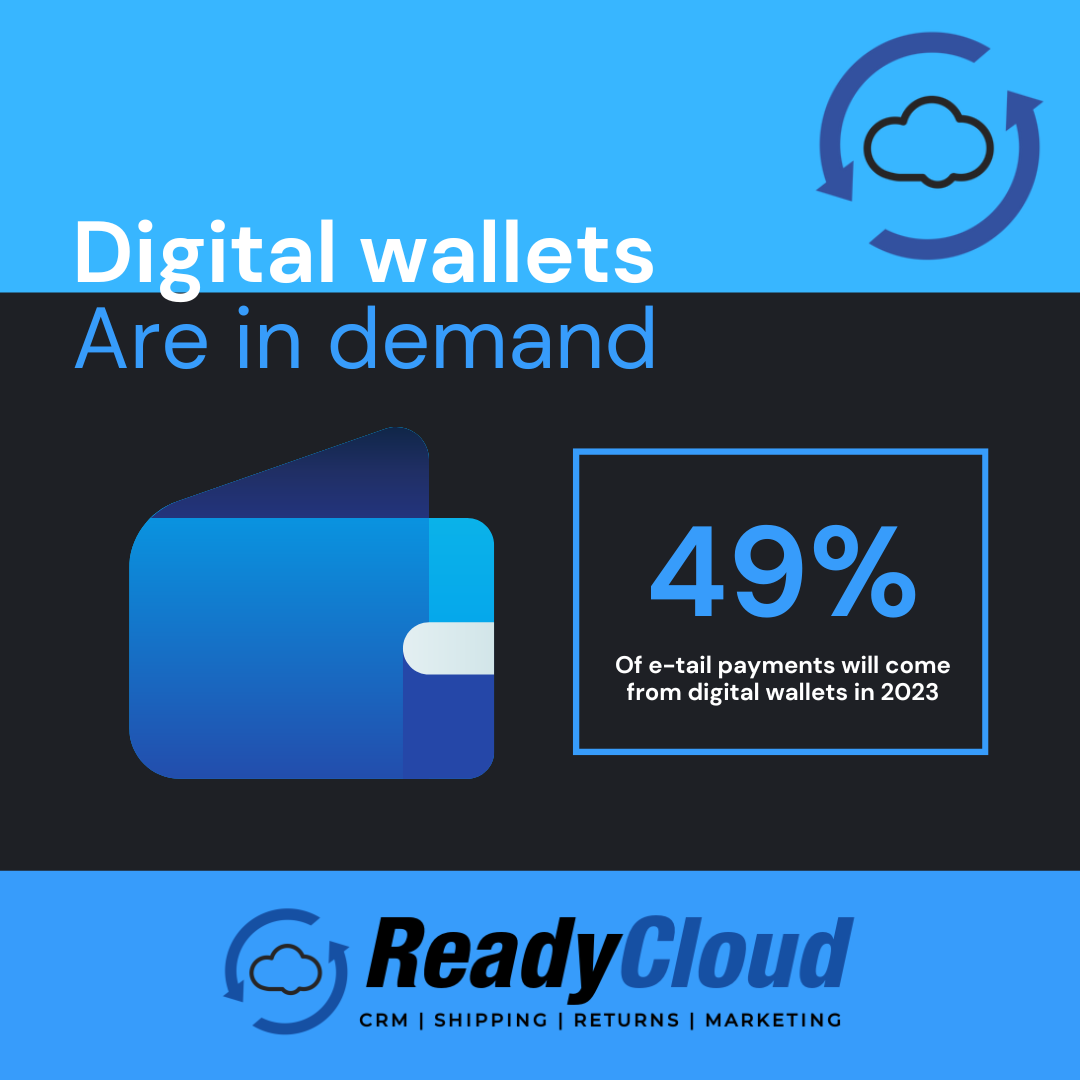
- Digital wallets have become an increasingly popular payment method in ecommerce due to their convenience and security features. According to FIS Global, digital wallets accounted for 49% of global ecommerce sales in 2021. This trend is expected to continue, with digital wallets potentially surpassing credit and debit card usage in the coming years.
- As of 2022, the top digital wallets in the U.S. market, according to Civic Science, were:
- PayPal (36%)
- Apple Pay (20%)
- Venmo (16%)
- Google Pay (11%)
- Samsung Pay (3%)
- Digital wallets are not only dominating ecommerce sales but are also becoming a popular choice for point of sale (POS) transactions. FIS Global reported that digital wallets accounted for 29% of global POS sales in 2021, surpassing credit cards (24%) and debit cards (23%).
- Although digital wallets are gaining popularity, credit and debit cards remain a significant payment method in ecommerce. FIS Global found that credit cards accounted for 21% of global ecommerce sales in 2021, while debit cards made up 13%.
- In North America, credit cards remain the top payment method for ecommerce transactions, at 31%. Digital wallets follow closely, with 29% of transactions. Debit cards account for 21% of ecommerce payments in the region.
- Buy Now, Pay Later (BNPL) options have emerged as a popular payment method in ecommerce, allowing customers to defer payment or spread it over a series of installments. FIS Global reported that BNPL accounted for 3% of global ecommerce sales and 4% of North American ecommerce sales in 2021.
- Several BNPL providers have emerged in the market, with some of the most prominent ones being:
- Afterpay
- Klarna
- Affirm
- Sezzle
- BNPL options have been particularly popular among younger consumers, with McKinsey & Company reporting that 60% of BNPL users in the U.S. were aged between 18 and 34.
- Bank transfers accounted for 7% of global ecommerce sales and 8% of North American ecommerce sales in 2021, according to FIS Global.
- According to Insider Intelligence, global retail ecommerce sales reached $6.310 trillion in 2023, with mobile commerce accounting for a significant portion of this figure.
- World Bank Group reported that 76% of adults worldwide had a bank account or used a mobile money provider in 2021, indicating a growing adoption of mobile payment methods globally.
- Despite the growth in digital payment adoption, a significant portion of the global population remains unbanked. The World Bank Group found that 1.4 billion adults worldwide were unbanked in 2021.
- Central Bank Digital Currencies (CBDCs) represent a potential future development in digital payment methods. According to the Bank for International Settlements, 9 in 10 central banks are actively exploring CBDC projects.
- 42% of US online shoppers prefer to use credit cards, while 29% prefer PayPal.
- Digital and mobile wallets are expected to account for a 50% marketshare of all ecommerce payments this year and beyond, increasing to a predicted 55% by 2025.
Cryptocurrency and Ecommerce
As cryptocurrencies continue to gain traction worldwide, their impact on various industries becomes increasingly evident. One such industry experiencing significant change due to the rise of digital currencies is ecommerce.
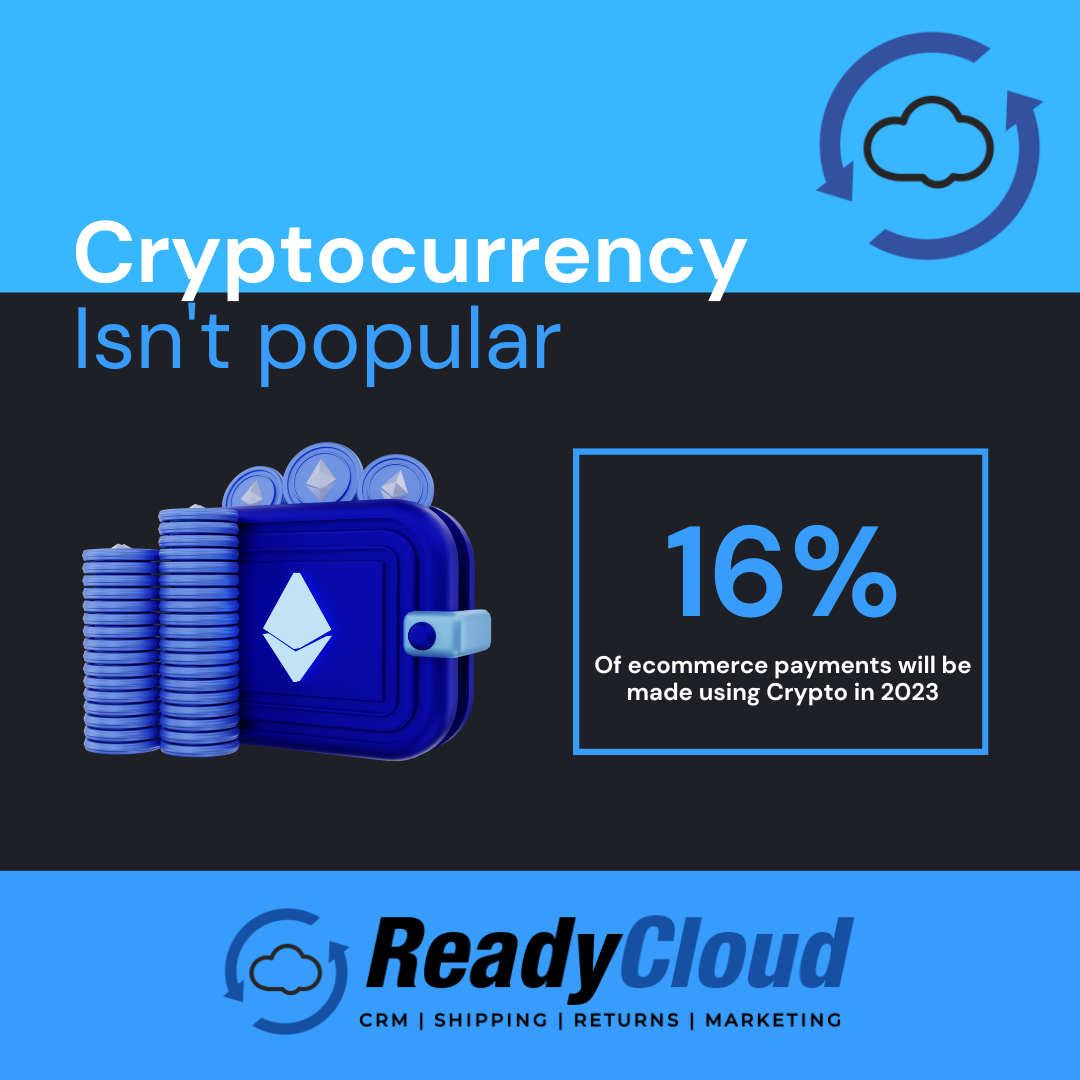
- According to Pew Research, as of November 2021, only 16% of U.S. consumers had used cryptocurrencies. This figure indicates that while digital currencies are becoming more mainstream, widespread adoption has yet to occur.
- In a survey conducted by U.S.-based Software Advice in May 2022, 596 U.S. consumers who had used crypto as a form of payment for online shopping were polled. The study revealed that all respondents had used cryptocurrency for online purchases at least monthly from June 2021 through May 2022.
- Despite the growing enthusiasm among some users, many U.S. consumers remain skeptical of cryptocurrencies. A Bloomberg “MLIV Pulse” survey conducted from July 5 to 8, 2022, revealed that retail investors are more skeptical of cryptocurrencies than institutional buyers. This skepticism may slow the adoption of digital currencies in ecommerce, potentially affecting the industry’s future growth.
- Cryptocurrencies often have lower transaction fees compared to traditional payment methods, making them an attractive option for both consumers and merchants. As more ecommerce platforms begin to accept digital currencies, it’s expected that the overall transaction costs associated with online shopping will decrease, leading to increased savings for both parties.
- 21% of US consumers have used cryptocurrency to make an online purchase.
Ecommerce Shipping
In the era of online shopping, ecommerce shipping has become a crucial aspect of any successful business. As an online retailer, staying updated with the latest industry trends and statistics is crucial for making informed decisions and optimizing your shipping strategy.

- Free shipping has become an essential offering for online retailers, with Walker Sands reporting that 79% of US consumers say free shipping would make them more likely to shop online. This highlights the importance of incorporating free shipping into your ecommerce strategy to attract and retain customers.
- High shipping costs are a leading cause of cart abandonment, with Baymard Institute reporting that 50% of online shoppers abandon their carts due to expensive shipping fees. Offering free shipping can help reduce cart abandonment rates and improve your overall sales.
- As consumer expectations evolve, the demand for faster delivery options is on the rise. A PwC survey indicates that 41% of online shoppers are willing to pay extra for same-day or next-day delivery. This presents an opportunity for ecommerce retailers to differentiate themselves by offering expedited shipping options.
- Offering same-day or next-day delivery can significantly improve customer satisfaction and loyalty. A Dropoff survey found that 89% of customers are more likely to shop with a retailer that offers same-day delivery, and 83% are more likely to recommend that retailer to others.
- As ecommerce continues to grow globally, cross-border shipping has become increasingly important for online retailers. A DHL report estimates that cross-border ecommerce will grow at an annual rate of 25% between 2020 and 2023. This highlights the potential for online retailers to expand their international customer base and increase sales.
- As environmental concerns become more prevalent, consumers are increasingly seeking sustainable products and shipping practices. A Nielsen study found that 81% of global consumers feel strongly that companies should help improve the environment. This presents an opportunity for ecommerce retailers to adopt eco-friendly shipping practices to appeal to environmentally conscious consumers.
- 87% of online shoppers consider delivery time before making a purchase.
- Offering same-day delivery can increase ecommerce sales by 20%.
- According to a recent Walker Sands report, 45% of US consumers receive one or two Amazon parcels weekly, on average. This figure is even higher for younger consumers, with around 55% of respondents aged 18-25 and 60% of those aged 26-35 receiving at least one parcel from Amazon weekly. As an Amazon seller, it’s crucial to be aware of faster shipping options that can help you stay ahead of the competition.
- Nobody likes to see unexpected shipping fees in their shopping carts, and studies show that almost 85% of US consumers are more likely to shop online if free shipping is available. To capitalize on this trend, consider incorporating shipping costs into each product’s retail price or setting a minimum spending threshold – known as a free shipping threshold – to encourage customers to complete their purchase.
- One of the main reasons consumers still shop in physical stores is the ability to have the product immediately. This preference is reflected in online shopping, with over 60% of shoppers aged 18-34 expecting same-day delivery. Not only do they expect it, but a considerable percentage are willing to pay extra for the service. If you don’t believe same-day shipping is essential, consider that more than 30% of shoppers would abandon an online cart if same-day shipping or next day shipping wasn’t available.
- While most online shoppers want speedy access to their products, recent research reveals that only 20% of US consumers are satisfied with the shipping options currently available. Among those who desire same-day shipping, 65% expect their packages to arrive within three hours of placing an order. The remaining percentage believes most ecommerce retailers, including Amazon, fall short in meeting their expectations.
- Consumers don’t just want regular communication about their orders; they also demand overall transparency, including clear delivery terms and conditions. In a related report, 55% of respondents said they would not purchase from a retailer if they didn’t know when their package would be shipped. In contrast, 57% claimed they would make repeat purchases if the retailer could accurately predict when the package would arrive. By partnering with reliable shipping companies, online retailers can enhance their businesses.
- A PayPal study found that 50% of shoppers abandon their carts if shipping fees are too high. This trend is linked to the “surprise fees” mentioned earlier. To retain customers and minimize cart abandonment, online retailers should consider offering free shipping or keeping shipping fees low.
- No one likes delivery delays, especially Millennials and Gen Z consumers who expect their orders to be delivered within 24 hours or less. Package exceptions are situations when a delivery is delayed for various reasons. However, another Convey study found that 97% of customers anticipate these exceptions to be resolved while their packages are in transit.
- In addition to consumers, Convey also examined retailer responses to customer expectations. The results revealed that 40% of respondents are concerned about shipping times, specifically how quickly their customers anticipate orders to be delivered. Additionally, 38% of online retailers worry about shipping costs and customer expectations surrounding free or low-cost shipping.
Ecommerce Personalization
In the rapidly expanding world of ecommerce, personalization has emerged as a critical factor for businesses striving to stay ahead of the competition. As consumer demands and expectations continue to evolve, businesses must remain agile and adaptive in order to provide unique, engaging experiences tailored to the individual needs of their customers. These ecommerce personalization statistics can help your brand gain (and keep) the upper hand over your rivals.

- According to a Forrester study, 77% of consumers have chosen, recommended, or paid more for a brand that provides a personalized service or experience.
- A Salesforce report reveals that 66% of consumers want businesses to understand their specific requirements and expectations, yet only 32% of retail executives believe they can transform data into tailored pricing, offers, and items in real-time.
- As per Super Office, 71% of customers feel frustrated when a shopping experience is impersonal, indicating that failing to deliver personalization can negatively impact customer satisfaction levels.
- Research by Epsilon indicates that 80% of shoppers are more inclined to make a purchase when companies provide tailored experiences.
- A Netcore study shows that personalization leads 44% of customers to become more loyal to a company.
- According to Accenture, 91% of customers are more likely to buy with brands that deliver relevant offers and suggestions to them.
- Invesp states that 56% of online customers are more inclined to return to a site that offers product recommendations, and 44% of customers who experience personalized shopping experiences say they’ll become repeat buyers.
- 46% of brands use machine learning for personalization, marking a 186% increase from 2018.
- Retail Dive estimates that retailers’ adoption of AI in personalization is set to save $348 billion per year in the 2020s.
- According to a Salesforce study, 60% of customers are open to the use of AI in customer engagement, including 66% of millennials.
- A Deloitte report shows that 22% of consumers are willing to share some information in exchange for more tailored product recommendations.
- Adobe states that 92% of online shoppers consider it crucial that brands respect the privacy of their personal information.
- An Accenture study reveals that 83% of consumers are willing to share their data to create a more personalized experience.
- Salesforce reports that 57% of online shoppers are ready to give their data for personalized offers and discounts.
- According to a Retail TouchPoints study, 38% of customers want personalization but don’t want to share too much data.
- A study by Aberdeen reveals that only 27% of businesses are completely satisfied with their capacity to create genuinely tailored customer experiences using data acquired across digital channels.
- Netcore reports that 96% of retailers have faced some obstacles in their personalization efforts, such as limited IT capacity, difficulty selecting the right partner, and issues aligning internal teams.
- According to Netcore, 41% of retail executives think their ecommerce platform is somewhat personalized, while 13% claim it provides a totally tailored experience.
- A SmarterHQ study states that 79% of businesses in the retail sector invest in personalization tools, which is higher than any other sector and may indicate that retailers stand to benefit the most from personalization.
- Netcore reveals that 77% of customers demand a more personalized customer experience.
- According to an Instapage study, 79% of customers are more inclined to engage with an offer if it is tailored to reflect past experiences with the brand.
- A Salesforce report shows that customers now expect offers to be tailored 52% of the time, up from 49% in 2019.
- Oracle states that 65% of shoppers believe tailored offers and incentives are the most significant aspects of their shopping experience.
- A Netcore study shows that 91% of shoppers would abandon an online retailer over a poor shopping experience.
- Research by Accenture reveals that a lack of trust and inadequate personalization costs $756 billion in sales each year.
- Smart Insights states that 63% of consumers will abandon firms that deploy bad personalization strategies.
- 47% of customers will turn to Amazon if the company they’re buying with doesn’t provide relevant product suggestions.
- A study by Evergage reveals that 98% of marketers believe personalization improves customer relationships.
- Adobe states that 43% of organizations with extensive personalization see significantly greater retention improvements from personalization.
- A Monetate study shows that 79% of organizations that exceeded revenue goals have a documented personalization strategy, compared to 31% of those that met revenue goals and 8% of those that missed revenue goals.
- Research by Aberdeen reveals that personalization resulted in a demonstrable increase in sales for 88% of organizations.
- A Netcore study shows that personalization increases average order value (AOV) for 98% of online retailers.
- According to Instapage, personalized shopping cart recommendations influenced 92% of shoppers online to buy products.
Customer Loyalty Programs
Customer loyalty programs are an essential component of a successful business strategy in today’s competitive market. By staying informed about the latest trends and statistics related to customer loyalty, businesses can make informed decisions about their loyalty programs, driving customer engagement, retention, and revenue growth. As we move into 2023 and beyond, businesses must continue to innovate and adapt their loyalty programs to meet the evolving needs and preferences of their customers.
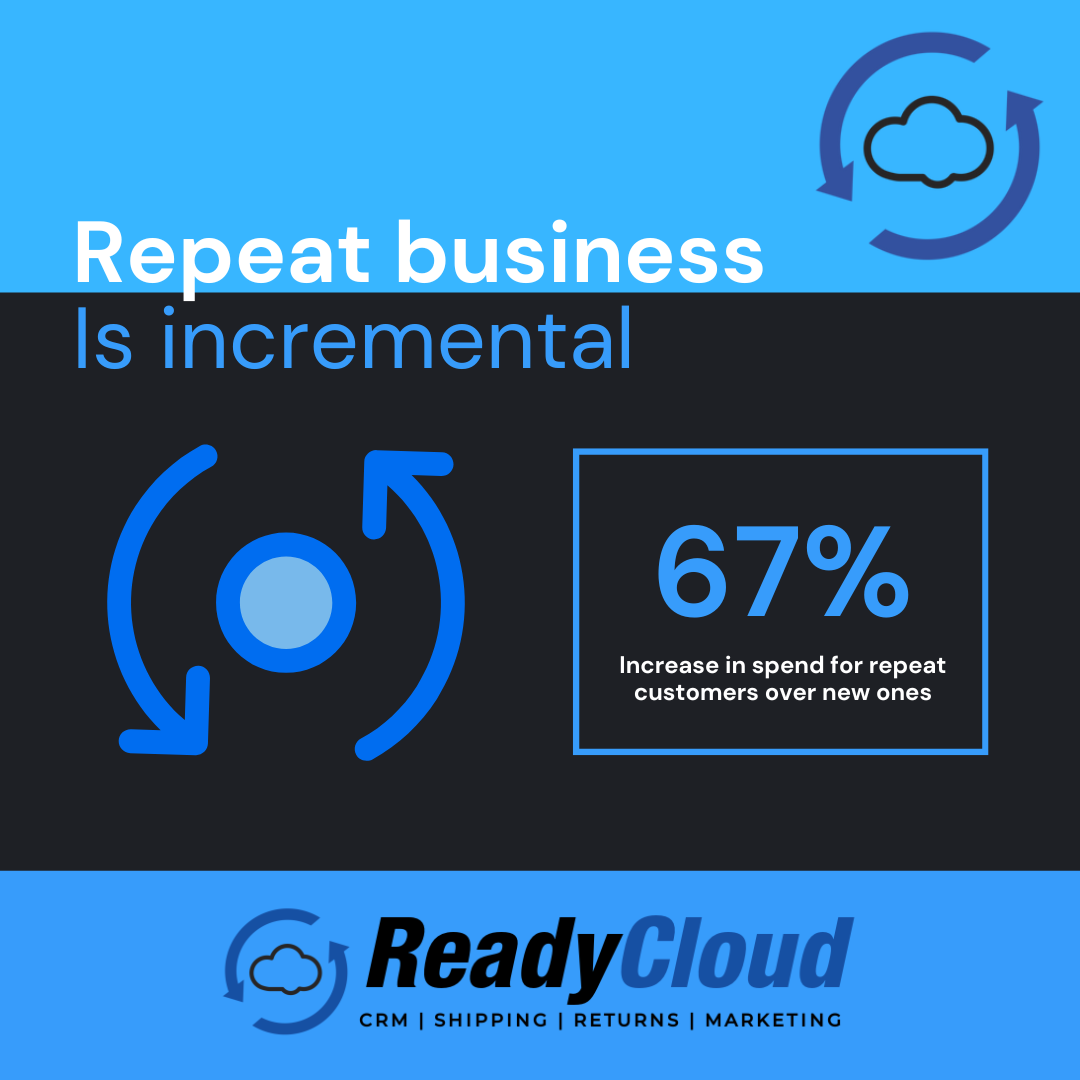
- A 5% increase in customer retention can lead to a 25% to 95% increase in profits. This highlights the importance of investing in customer loyalty programs to keep customers coming back.
- Repeat customers tend to spend more than first-time buyers. In fact, repeat customers spend up to 67% more than new customers. This highlights the potential revenue gains from implementing a successful loyalty program.
- Acquiring new customers can be expensive. According to Harvard Business Review, it can cost five to 25 times more to acquire a new customer than to retain an existing one. This further emphasizes the importance of customer loyalty programs in reducing acquisition costs and increasing profitability.
- 79% of consumers are more likely to continue doing business with a brand that offers a loyalty program. This demonstrates the impact of loyalty programs on customer retention and overall business success.
- 80% of consumers are more likely to do business with a brand that offers personalized experiences. This underscores the importance of tailoring loyalty programs to individual customer preferences and behaviors.
- 77% of consumers prefer using technology to engage with loyalty programs. This highlights the need for businesses to invest in digital solutions to deliver seamless, engaging loyalty experiences.
- 70% of consumers would be more likely to use a loyalty program if they could access it through a mobile app. This emphasizes the importance of offering a mobile app to enhance customer engagement and loyalty.
- Integrating loyalty programs with mobile payment solutions can drive customer engagement and repeat purchases. 57% of consumers have used a mobile wallet to make a purchase, and 94% of these mobile wallet users have participated in a loyalty program.
- Starbucks Rewards is a prime example of a successful customer loyalty program. The program boasts over 16 million active members and contributed to 40% of Starbucks’ US sales in 2018. Starbucks Rewards effectively leverages a mobile app, personalized offers, and a tiered rewards structure to drive customer engagement and loyalty.
- Amazon Prime has become a powerhouse in the world of customer loyalty, with over 200 million members worldwide. The subscription-based program offers a wide range of exclusive benefits, including free shipping, access to streaming content, and special discounts. Amazon Prime’s success demonstrates the potential of subscription-based loyalty programs to drive customer loyalty and revenue growth.
- 72% of US consumers belong to at least one loyalty program.
Even More 2023 Ecommerce Trends to Know
With these essential ecommerce statistics in your arsenal, you’ll be better equipped to understand the current market trends and make informed decisions for your online business. Remember to stay up-to-date with industry news and research, as the ecommerce landscape is ever-changing. Take a look at this illustrated infographic we’ve created that outlines and details all of the most important ecommerce trends you should be paying attention to in 2023 and beyond.
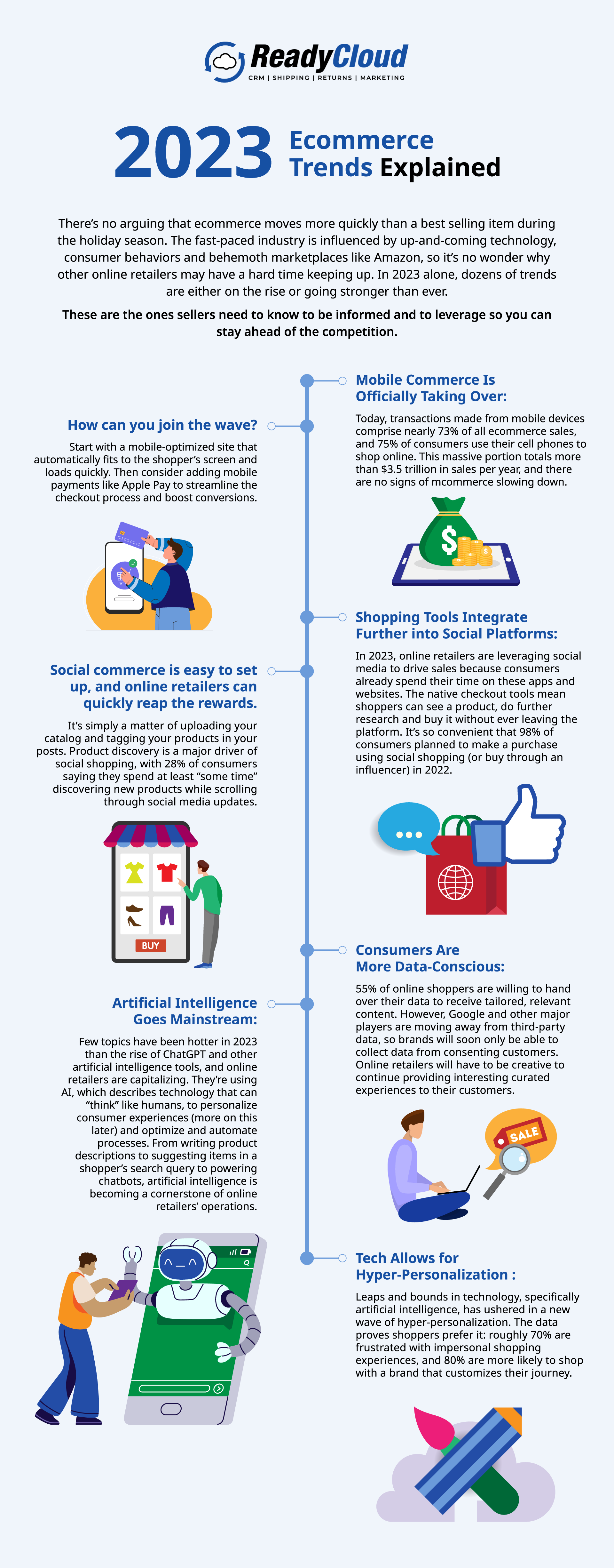
What You Should Do Now
Here are 3 ways ReadyReturns can help you deliver amazing return experiences that eliminate prepaid labels and boxes, delight customers, and protect your margins:
Schedule a Demo – See how ReadyReturns turns product returns into your competitive advantage with “Amazon-like” returns and cost-saving features.
Start Your Free Trial of ReadyReturns (No CC Required) – Set up in minutes. Instantly offer QR code returns, product exchanges, and custom return rules that turn frustrated customers into repeat buyers.
Try Readycloud at No Cost – Why manage shipping and returns separately? Get ReadyShipper X, ReadyReturns, and more in one unified platform for seamless fulfillment and order management.
Share On:








